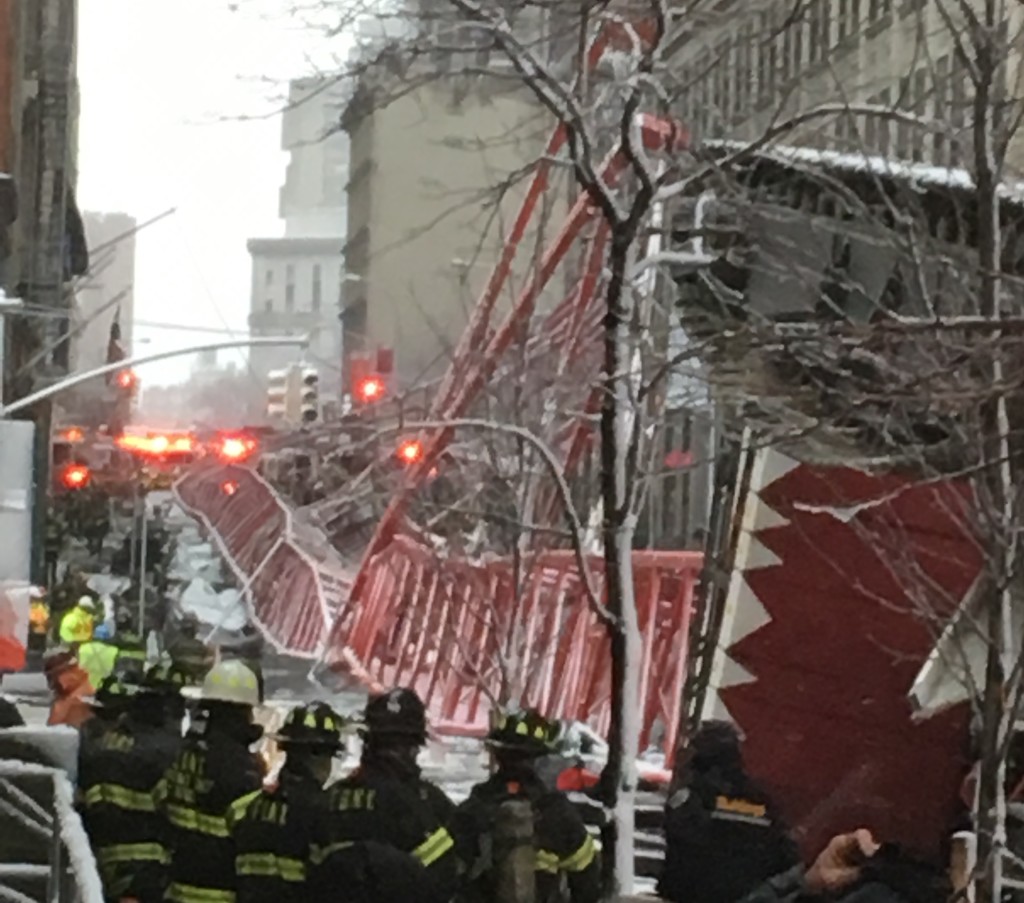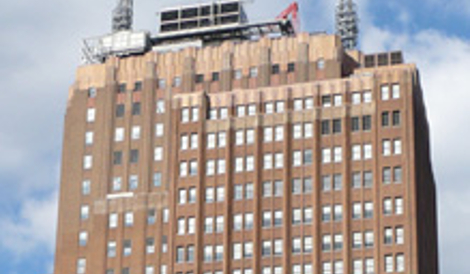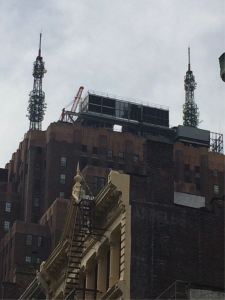The Collapse of a Crane in Tribeca is the Collapse of a Bad Idea
– From Happy Office Building to Miserable Factory in a Residential Area-
Today in Tribeca a crane fell from 28 stories high, landing along Worth Street itself. It killed a New Yorker and injured three others. Their names have not been released. The crash caused extensive property damage to four neighboring buildings whose parapets are in danger of collapse. The video is all over the internet.
Many New Yorkers have visceral fear of such tragic events, which may be why the Mayor held a press conference, which I just watched. He warns residents there will be heavy pedestrian blockages, traffic and subway delays and logistical disruption for many days. I also learned it was a crane that could to go up 564 feet. Of course, I already knew why it was there: to install yet another of those immense generators that defile the high-floor terraces of the massive, full-block, landmarked Western Union Building, designed by Ralph Walker in the 1928. Those who live here know: there are always cranes on the Western Union, even though it was built in 1928.
This particular crane had been a couple of blocks from my house, installed on Worth Street between West Broadway and Hudson Street. My daughter’s pre-school is opposite the Western Union and another preschool is two blocks away. The New York Law School and the New York Academy of Art are kitty-corner and also filled with students. If the crane had fallen in any other manner the catastrophe would have been even more unimaginable. The Western Union Building is in fact surrounded by co-ops and condos and small businesses. I look directly at it from my desk.
The impact of its fall shook my 13-story (load-bearing masonry) building for several seconds, even though I am on the sixth floor some two blocks away. The impact also broke a water main. There are gas leaks everywhere: Con-Ed is out in force fixing them. It is interesting that the Mayor, during his press conference, never once mentioned the name of the neighborhood where it happened, calling the area “Lower Manhattan.” He brushed off a journalist who said there had been an “epidemic” of crane accidents in the past ten years. He also brushed aside any notion of “over-development” when queried by another journalist. My guess is that it will be called a regrettable accident, the normal cost of doing real estate business in Manhattan. But is it?
From where I sit, this was not a problem of over-development per se, nor an abuse of the permitting and inspection system, although those may be factors. It was instead, an avoidable accident that had long been waiting to happen. In fact it could have been reasonably expected to happen. How so? The problem lay at the city’s decision to abuse a landmarked building by allowing a real estate investment trust to convert the Western Union Building away from its traditional (and welcomed) office use to an unwelcome industrial use, via a black hole in the zoning code. It became an “internet factory.”
When I first moved here (not that far back) it was, despite its excessive bulk, a warm and inviting office building at street level with stores all around – including a Brown Derby Diner, a publicly accessible lobby with charming wooden phone booths, and even an auditorium. On sunny days when the brick glowed, we liked the building. On dark days it seemed too monolithic. Office workers from there filled our neighborhood parks and lunch spots on sunny days. When the idea came up to convert it to a factory, the neighborhood fought the decision and lost. The Landmarks Commission rolled over and said little. The developer proceeded to empty it of its office workers. Many windows were sealed up and converted to industrial ventilation spots. The auditorium was ripped out. Passerby’s were forbidden to go in. It slowly became a moated, hostile presence in the middle of a residential neighborhood. Now, the pipes of diesel generators and the noise of the back-up air conditioners have made stretches of Worth and Thomas Streets nearly unlivable unless you seal your apartment like a fortress. It became a noxious, polluting factory of the internet age, our own stinking modern, slaughter-house or satanic mill producing the digerati’s back-up system.
That ill-considered and much-protested decision to “go industrial” for this building has meant bad things for Tribecans: constant construction, constant permits, constant cranes and constant scaffolding over a 25-year period, creating non-stop noise heard from several blocks away often for 24-hours at a time, pollution from diesel emissions, construction danger, and constant disruption to the surrounding streets as new cabling is installed under the street on a weekly basis for the “internet factory.” The building manager there once said to me: “I feel sorry for you, I know what is going to happen here.” Complaints about all the noise and stink and construction were routinely ignored, be the complaints from neighbors or the community board. The upshot is this: given the non-stop, truly incessant modifications to this building that the city has facilitated and encouraged over so many years, it was just a matter of time before an accident like this would happen. This was not a case where a crane goes up for a while to build a building and then it is gone. The cranes are here at a terrifying frequency that this neighborhood cannot withstand.
At the time of the decision, all these negative social costs were happily thrust upon Tribeca. When we considered a lawsuit to stop it all, we were told by the developers that only the Western Union Building could house the internet, because of the building’s unique pneumatic tubes in the walls, once used to send telegrams around the city….. Really? Lots of cities have the internet and hardly any have Western Union landmarks. That bit of nonsense was finally revealed for the lie it was in 2014, when Peter Feldman, the founder of “Datagryd,” one of the companies putting the generators up on the high floors of the building said in an interview to the press: “We had to modernize and future-proof the building. We had to turn the building inside out to do it.”
That “turning inside out” has been going on for 25 years now and shows no sign of abating. That is why cranes are always there. If they are always there, the probability of an accident rises. And all this danger happens before we even mention all the diesel fuel stored in there, fuel that should not be there.
Conclusion: this is the wrong place for a factory as noxious as this, internet or otherwise. This once great building needs to be incrementally returned to its office use, and the “internet factory” slowly dispersed and the endless construction that this iconic building suffers must stop. Then there will be no need for cranes every two weeks and we will be safe.
As always, corrections welcome. Read Peter Feldman’s quote in the original here.





